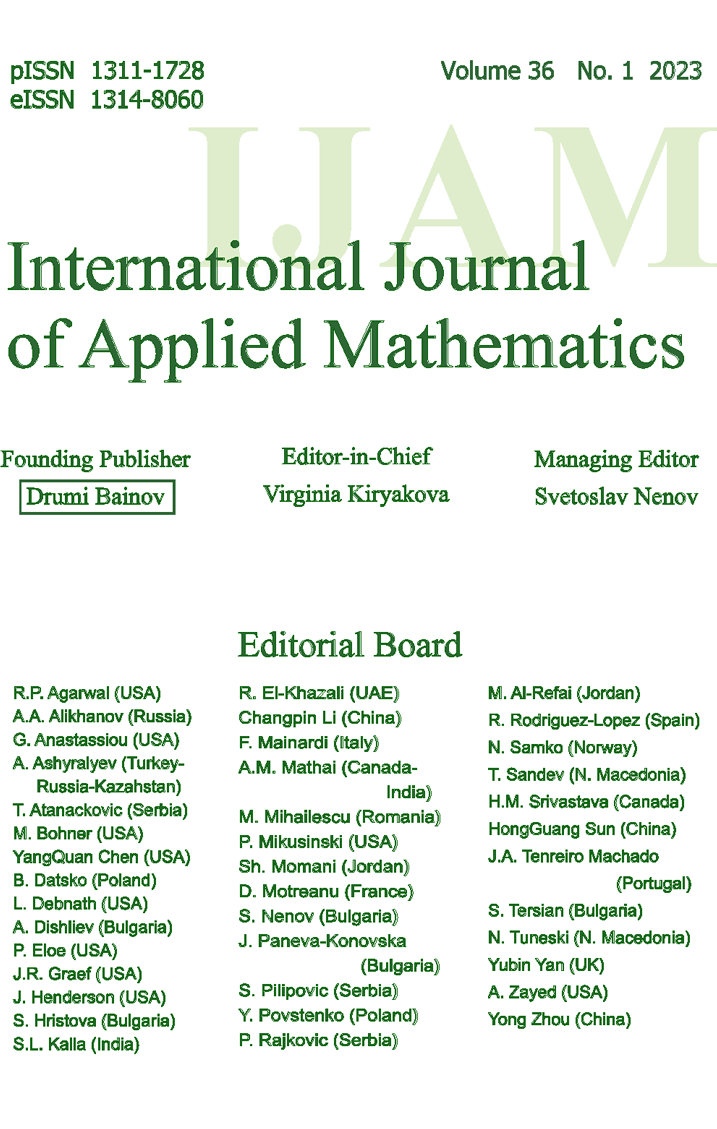THE TRUNCATED ISHITA DISTRIBUTION:
PROPERTIES AND APPLICATION
PROPERTIES AND APPLICATION
Abstract
In this paper, a new truncated distribution, which is called the truncated Ishita (TI) distribution, is proposed. Some statistical properties including moments, survival, and hazard functions, are discussed. Moreover, the maximum likelihood estimation is constructed for estimating the parameters of the TI distribution. Finally, an application based on real data is conducted to illustrate the usefulness of the proposed distribution.Citation details of the article
Journal: International Journal of Applied Mathematics Journal ISSN (Print): ISSN 1311-1728
Journal ISSN (Electronic): ISSN 1314-8060
Volume: 33 Issue: 1 Year: 2020 DOI: 10.12732/ijam.v33i1.8
Download Section
Download the full text of article from here.
You will need Adobe Acrobat reader. For more information and free download of the reader, please follow this link.
References
- [1] R. Shanker, F. Hagos and S. Sujatha, On modeling of Lifetimes data using exponential and Lindley distributions, Biometrics & Biostatistics International Journal, 2 (2015), 1-9.
- [2] H.C Thom, A note on the gamma distribution, Monthly Weather Review, 86 (1958), 117-122.
- [3] M.A.T. Figueiredo and A.K. Jain, Unsupervised learning of finite mixture models, The IEEE Transactions on Pattern Analysis and Machine Intelligence, 24 (2002), 381-396.
- [4] R. Shanker and K.K. Shukla, Ishita distribution and its applications, Biometrics & Biostatistics International Journal, 5 (2017), 1-9.
- [5] Y. Dodge, The Oxford Dictionary of Statistical Terms, Oxford, The Oxford University Press (2003).
- [6] S.K. Singh, U. Singh and V.K. Sharma, The truncated Lindley distribution: Inference and application, Journal of Statistics Applications & Probability, 3 (2014), 219-228.
- [7] N.L. Johnson, S. Kotz, and N. Balakrishnan, Continuous Univariate Distributions, Wiley, New York (1994).
- [8] L. Zaninetti and M. Ferraro, On the truncated Pareto distribution with applications, Central European Journal of Physics, 6 (2008), 1-6.
- [9] S.E. Ahmed, C. Castro-Kuriss, E. Flores, V. Leiva, A truncated version of the Birnbaum-Saunders distribution with an application in financial risk, Pakistan Journal of Statistics, 26 (2010), 293-311.
- [10] T. Zange and M. Xie, On the upper truncated Weibull distribution and its reliability implications, Reliability Engineering & System Safety, 96 (2011), 194-200.
- [11] S. Aryuyuen, Truncated two-parameter Lindley distribution and its application, Journal of Applied Sciences, 17 (2018), 19-32.
- [12] S. Aryuyuen and W. Bodhisuwan, The truncated power Lomax distribution: Properties and applications, Walailak Journal of Science and Technology, 16 (2018), 655-668.
- [13] J.E. Dennis and R.B. Schnabel, Numerical Methods for Unconstrained Optimization and Nonlinear Equations, Prentice-Hall, Englewood Cliffs, N.J. (1983).
- [14] R.B. Schnabel, J.E. Koontz and B.E. Weiss, A modular system of algorithms for unconstrained minimization, ACM Transactions on Mathematical Software, 11 (1985), 419-440.
- [15] R Core Team, R: A Language and Environment for Statistical Computing, R Foundation for Statistical Computing, Vienna, Austria; http://www.Rproject.org (2018).
- [16] E.J. Fuller, S. Frieman, J. Quinn, G. Quinn and W. Carter, Fracture mechanics approach to the design of glass aircraft windows: A case study, SPIE Proc., 2286 (1994), 419-430.

